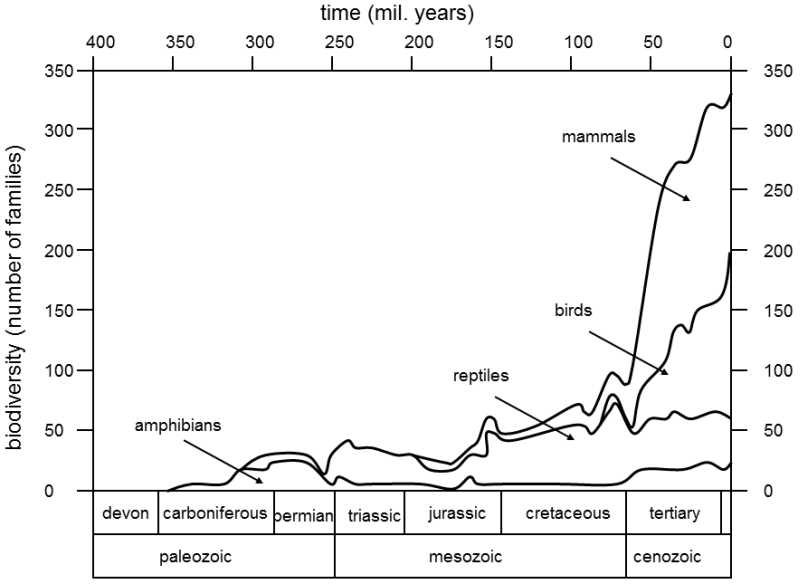XXII.5.4.3 After a space of the order of ten million years, the original biodiversity is restored in the communities as a result of a faster rate of speciation
After several million years, the original biodiversity is gradually renewed by splitting of existing species, speciations.The rate of speciation apparently culminates approximately 10 million years after the end of a mass extinction.Simultaneously, it seems that the length of this interval is not directly correlated with the number of species affected by extinction (Kirchner & Weil 2000b; Kirchner & Weil 2000a).So far it is not at all clear which mechanism maintains a sort of homeostasis in the number of species occurring simultaneously in the environment; one of the possibilities is discussed in section XXII.7.However, it is clear that, over the entire Phanerozoic period, i.e. a period of more than 500 million years, the number of speciations has been almost identical with the number of extinctions.There is a difference of only 0.1 – 1 %.Consequently, the overall biodiversity, expressed as the number of simultaneously living species, increased only very slowly over time, even though some taxa underwent turbulent development in certain periods (Fig. XXII.8).

Fig. XXII.8 Increase in the diversity of tetrapods. The graph depicts the progress of the gradual increase in the number of families of terrestrial vertebrates during the Phanerozoic. Modified according to Benton (1997).
Mass extinction means greater or lesser temporary reversal of this increasing trend; then, however, the biodiversity rapidly returns to the original value after the ten million year period.Sometimes these results are interpreted as evidence for the existence of only a limited number of potential (empty or utilized) ecological niches that are available for species in the particular environment.As the number of species gradually increases and especially with their mutual diversification, new niches are formed, so that the total number of potential niches increases.If there is a drastic reduction in the number of species, the overall biodiversity, expressed as the number of species, is smaller, but the disparity, i.e. the biodiversity expressed as the degree of their mutual divergence, i.e., for example, as the number of higher taxa, decreases far less or does not even change.Thus, the number of potential niches is more or less preserved and empty niches left by extinct species are subsequently filled through speciation.As especially formerly dominant taxa can be eliminated from nature during extinction and the members of other taxa can gain an opportunity for expansion, the biodiversity can increase in a great many ecosystems and even overall biodiversity can increase after the end of a mass extinction event {11943}.
